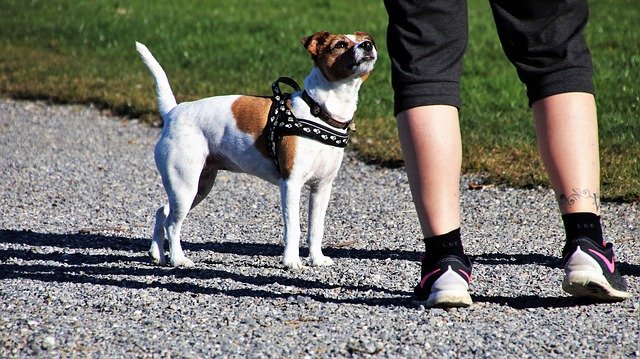What can I do instead of scolding my dog? When we talk about education, we often talk about punishment and prohibition. Is the punishment necessary for the life of the dog? What about the bans?
Often times clients tell me, “I’m all for positive reinforcement, but what am I supposed to do when my dog does something that I don’t want him to do?”
Should we just ignore it? One tool that you can put into place effectively is a positive switch!
What is a positive switch?
What can I do instead of scolding my dog? Put a positive switch! A positive switch consists of conditioning your dog to a noise that will mean: “Stop what you are doing and come towards me.”
This is ultimately one of the best ways to get your dog’s attention in a positive way. So you don’t need to inhibit it or scold it. It is much more productive and allows you to maintain a harmonious relationship with your dog.
You will therefore condition your dog to a pleasant noise. Indeed, it is not a question of conditioning it to a stressful noise at the base, but of finding a friendly noise for your dog. The aim is for this noise to be the signal to stop an action and allow the dog to be redirected to a more desirable action.
The purpose of this switch will be to prevent or stop an action or behavior that you consider undesirable at the time. In short, this switch will replace your “no”. Being used on a daily basis, it has no more meaning and is not acquired in a positive way. You have the chance to put some glitter and color in your dog’s life, so do it!

Why not just use “no”, my dog’s name, or shout?
First of all, the “no” is often used during the day and has very little meaning for the dog. Indeed, “no” is not conditioned and is often associated on the job with negative emotions coming from the teacher. This puts the dog under stress, but does not teach him what to do instead.
So this removes the bad behavior instead of giving your dog another good behavior. However, your goal should be to let your dog know what you want him to do, not to pick him up when he “hurts”.
When you scold your dog, he is bound to associate you with the punishment. Therefore, your dog will learn that the punishment will only happen when you are there. When you are away, that will not prevent it from starting over.
The consequences can be numerous and sometimes insidious, such as causing a bad recall because your dog is not clearly aware that he can trust you.
Likewise, you must not use your dog’s first name for the “punished”. Indeed, his name is not a punishment. This only serves to challenge him. In addition, his name is used in a lot of different contexts. This only destroys the dog in our exchanges.
When can I use a positive switch?
This switch can be used in many situations. Preventing your dog from chewing your shoes. Stopping your dog when he tries to make a hole in your vegetable garden. Eliminating other unwanted behavior.
Warning: Behaviors designated as undesirable for some are not necessarily so for others.
Choose a switch
Choosing your switch is very easy. When you say it, it has to put you in a positive emotional state. This is a first commitment on your part. Some people choose the sound of a kiss or a funny word like “boo-boo”. When your choice is made, all you have to do is charge your dog to that noise or word, in order to create conditioning.

5 steps to condition your dog
Here are the 5 main steps for conditioning your dog to the positive switch. Only exercise if you are in a good mood. Train in a hypostimulating environment (so calm like a room in the house for example). Prepare rewards like treats or toys to strengthen your dog. During all these stages, it is forbidden to say “no” or to inhibit your dog. Face your dog and start the exercise:
1- Make your noise / word and immediately give the reward to your dog. Repeat this step several times. Do sessions of 10 reps. It may take several days for your dog to react directly to this noise.
2- Make the noise, wait for your dog to look at you. As soon as he makes contact say a “yes” to him and reward (toy, treats). If your dog does not look up, it may be that the first step is not understood or that the environment is poorly chosen. So go back to the previous step.
3- Once your dog immediately looks at you every time you make noise, try adding distractions. At the beginning these distractions should be commensurate with his level. They should therefore not be too difficult. Repeat, repeat, repeat, this is the key to success.
4- Go for a walk, or simply change rooms, to distract the dog. Make noise and reward as soon as he looks at you and / or comes back to you. During this step, if you are out for a walk, let your dog lean on. Thus, he will not be able to validate himself in bad behavior.
5- And for the last step, your dog is no longer necessarily facing you. He must be able to give up what is happening or what he is doing to come and get his reward. If this step fails, move away from the distraction and generalize the previous step to more distractions. If it still fails, make the distraction less interesting and / or consider taking a higher reward.
The essence of this learning
Regarding this learning, there are essential things to remember. Here they are :
• After interrupting your dog, let him know what to do instead. It’s very important to him and to you. Otherwise, your dog won’t know what to do instead and will continue to do what bothers you. For example: if your dog eats table legs, interrupt him and then tell him to go get his toy or give it to him.
• Many dogs view punishment as another form of caring. If the only time you pay attention to your dog, it’s when he’s doing something that’s bothering you. He will repeat this behavior, to get your attention.
• Finally, tell yourself that behind every action your dog does is an emotion. So, behind every emotion there is a need that is not met or not adapted. To do this, it is imperative that your dog’s needs are met. For example: it requires him to feel safe. He has to explore outside his home every day, even if his master has a garden. Dogs need positive and healthy social interactions with humans and other dogs on a regular basis.
To conclude: in reality, your dog doesn’t need to be scolded, if you have taught him the “rules” that you impose on him. Too often we tend to believe that our dog knows what is expected of him. The reality is quite different. The dog very rarely understands what is expected of him. It is therefore necessary to be caring, respectful and patient, to have a successful education.
